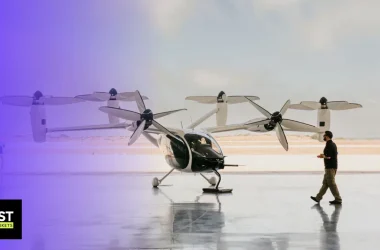On January 5th 2024, chaos erupted in an Alaska Airlines (NYSE: ALK) flight from Portland to California, when the plane’s door plug suddenly came off just minutes after takeoff, exposing the plane’s interior and terrifying everyone on board. The pilots managed to fly back for an emergency landing, but this marked the beginning of a nightmare for the company that made the plane, Boeing (NYSE: BA).
BA stock has plummeted by a staggering 27% ever since, and some passengers filed a $1 billion lawsuit against the company, but what made Boeing’s woes even worse, a whistleblower was found dead on the same day he was meant to testify against the company, leading many to think the company was involved somehow. All of this raises one question: Is this the end for Boeing?
The Alaska Airlines Flight
In the infamous Alaska Airlines flight incident with the Boeing 737 MAX, some on board sustained minor injuries, but fortunately there were no deaths, as no one was sitting in the two seats next to where the door blew up. Alaska Airlines described this as a miracle, since the flight had been almost fully booked, with 171 passengers on board out of the plane’s full capacity of 178, so just two of the seven empty seats on the entire flight were side by side next to the torn door plug.
But, what really caught people’s attention is that the plane involved in the accident was a Boeing 737 MAX 9, a plane from a family of jet airliners that has long been problematic. In fact, this is only the most recent in a series of 529 accidents tied to this aircraft. Two days after the accident, the FAA issued an order requiring all operators to check the rear mid cabin exit door plugs, and launched an investigation to determine what went wrong. Additionally, it grounded all 737 MAX 9 aircraft until further notice.
What Went Wrong?
According to American aviation regulations, the number of emergency exits in a plane should depend on the number of passengers. For example, a 737 MAX 9, that can hold up to 220 seats, requires a total of 10 exit doors in order to ensure the minimum evacuation time of 90 seconds, as mandated by the regulations.
But, Alaska Airlines only outfitted 178 seats, and since that’s less than the original capacity of 220, the aviation laws allow removing the two mid rear cabin emergency exit doors to reduce weight and maintenance costs. Then, the emergency exit doors get replaced by a bolted panel or plug and that is what a door plug is. A door plug is held in place with four bolts, but during the Alaska Airlines flight, it blew off cleanly without leaving significant damage on the plane’s fuselage, which many considered was extremely strange.
This led to other 737 MAX 9’s being inspected to determine why that happened, and to many people’s surprise, the FAA said that some carriers reported loose bolts on the door plugs and other hardware in their 737 MAX 9’s. This explained why the door came off without doing great damage to the fuselage, and raised some serious red flags over Boeing’s manufacturing and quality control, which put the company under intense scrutiny from the public for the third time in less than 10 years.
The Aftermath
As a result of the Alaska Airlines accident, Boeing and the airline are now facing a $1 billion lawsuit from three of the passengers that were on board that day, and these passengers are saying that the accident only happened because of negligence, and now seek both compensatory and punitive damages. Not only that, but Boeing is also facing another class-action lawsuit that was filed on behalf of six passengers and a relative in Washington state, where Boeing is headquartered. This lawsuit alleges that “the event physically injured some passengers and emotionally traumatized most if not all aboard.”
The strangest thing to come out of this entire saga was the death of whistleblower John Barnett, who was a former Boeing employee known for raising concerns about the firm’s production standards, having worked in the company for more than 30 years. Barnett was found dead from a self-inflicted gunshot wound in his truck, and what makes his death so strange is that he had been testifying and giving evidence against the company in the days before his death, and he was found dead on the same day he was supposed to appear in court to answer more questions, which caused many to be suspicious of the timing of his death.
What’s even more suspicious is that Barnett apparently told a family friend that he predicted that he would die and that there would be a story that would come out that he killed himself, saying: “if anything happens to me, it’s not suicide.”
This friend, who identifies herself as Jennifer, said that she knows Barnett didn’t commit suicide and that he loved his family and friends too much to do so. She strongly believes that somebody “didn’t like what he had to say” and wanted to “shut him up” without it coming back to anyone. Barnett started going against Boeing in 2019, the same year when he told the BBC that workers had been deliberately fitting sub-standard parts to aircraft on the production line.
What’s Wrong with Boeing’s Manufacturing?
Boeing’s planes are mostly assembled by real workers, as not everything in manufacturing is automated in the aviation industry, and since these are real people working and not robots, they’re bound to make mistakes if the management pushes them or overworks them. Usually, good quality inspections will deal with those mistakes, but according to whistleblower Ed Pierson, Boeing didn’t have enough inspectors to check for the mistakes, and the ones it had weren’t doing their job properly.
This means that Boeing really dug its own grave, but it’s also fair to say that Alaska Airlines is equally to blame, as that particular MAX 9 had not just one, but three recent depressurization incidents before the flight, so the company must’ve known that something was wrong with the plane. Not only that, but Alaska Airlines recently confirmed that the same plane was scheduled to undergo maintenance later that night.
Notably, Alaska Airlines stated that no one being assigned to the two seats next to the faulty door plug was pure luck after the accident, but now that this was revealed, many started questioning if that’s even the case, and started accusing the airline of purposely avoiding assigning passengers to those seats because it knew something was wrong.
The Dark History of the Boeing 737 MAX
Alaska Airlines’ involvement doesn’t justify the fact that multiple other airlines reported that their Boeing 737 MAX jets have loose door plug bolts, that’s all on Boeing, and it’s why the company drew more attention. But, the loose bolts are just the tip of the iceberg for Boeing, and another reason why the company drew so much attention is the 737 MAX’s awful history.
This plane has the world record for the longest grounding in the aviation industry’s history, and is infamous for two previous fatal crashes that resulted in the deaths of almost 400 people, the Lion Air flight 610 and the Ethiopian Airlines flight 302. There were no survivors in either crash, and both crashes had one thing in common: a faulty angle of attack sensor provided wrong data to the 737 MAX’s new computer flight control system, which led to the system thinking the plane was about to stall, so it responded by going down, resulting in a crash.
Why Can’t Boeing Just Discontinue the 737 MAX?
It’s unlikely that Boeing will choose to discontinue the 737, because it is the company’s best-selling jetliner of all time, and also the world’s top selling aircraft. In fact, as of December of 2023, 16,459 Boeing 737s have been ordered and 11,660 have been delivered. This is because since its release in 1968, the 737 received a reputation for being cheap and reliable, and while it wasn’t as efficient as newer airplanes, that didn’t matter to the airlines, which were using the 737 jets for short-haul flights only.
But, in the early 2010s, companies like Airbus (OTCMKTS: EADSF) started creating newer single aisle planes that could cover longer distances. Additionally, between 2008 and 2013, prices for jet fuel had reached an all-time high, and this made fuel efficiency much more important to airlines. Therefore, they started searching for smaller and more efficient planes, and Boeing saw an opportunity for its 737 jets, but the biggest turning point for Boeing was when its biggest customer, American Airlines (NASDAQ: AAL), announced the largest order in aviation history in 2011.
This order included 460 new planes, including 100 planes of Boeing’s expected new evolution of the 737NG family, which were going to be released in 2013 with a new engine that would offer better fuel efficiency. At the time, the planes hadn’t even been announced by Boeing, so American Airlines basically forced Boeing to build a new plane with the oldest airframe in its current production, starting the fourth generation of Boeing’s popular 737 series.
The reason why Boeing and American Airlines preferred a 737 remodel, rather than a completely new modern plane that didn’t date back to the 1960s, was because this would save a lot more money, as new plane designs need to be approved by the FAA and other aviation regulators around the world, which is a process that could take years and cost millions of dollars. On the other hand, making a new model airplane based on an old previously approved one was much easier to pull off and less costly, as Boeing would only need to certify the things that changed. Therefore, it’s no surprise that Boeing ended up rushing the production of these planes, especially when you consider the fact that it desperately wanted to meet demand and avoid losing money and market share to competitors like Airbus.
Airlines like American Airlines would greatly benefit from this, as they’d get their ordered planes faster, and there’s also the fact that they won’t have to wait for their pilots to get certified for flying new planes, because a pilot trained to fly one 737 model was considered capable of flying all other models in the family. This means that the pilots don’t need a separate certification or training for every 737 model, so it’s easy to see how the airlines benefited because in the case of a new plane, airlines would’ve had to invest time and money into training pilots.
Boeing simply couldn’t say no to American Airlines, because this would’ve made it lose its most important client, and this would’ve been a nightmare for the company’s shareholders. Therefore, a little over a month after American Airlines announced its order, Boeing announced the 737 MAX as the new variant of the old 737 with a 15% increased fuel efficiency that would make it feasible as a transatlantic aircraft.
Since the Boeing engineers were now tasked with increasing the efficiency of an airplane with an old design, they ended up swapping the old engines with newer bigger CFM LEAP-1B engines, and this was a problem because the original 737 design is quite low to the ground, so they had to move the engine mount forward and up to make it fit without making the landing gear any bigger.
This significantly changed the original characteristics of the 737, and put the aircraft in danger of stalling, so Boeing added the computer system we mentioned earlier to make up for the differences. But, this system was the cause of two of the biggest accidents in the company’s history, as the pilots of these flights didn’t know about this system and didn’t know how to disengage it, considering that Boeing represented this big change as a simple upgrade to the plane, and purposely avoided mentioning it, in order to avoid the FAA forcing pilots to train on it, and that was its most fatal mistake.
Is This the End for Boeing?
In 2023, Boeing booked orders for nearly 1,500 airplanes valued at $125 billion, but January of 2024 saw some customers canceling, like Air Europa, which canceled an order for one Boeing 787-9, and one or multiple unidentified customers canceled orders for two Boeing 737 MAX airplanes. Boeing did book orders for three airplanes valued at $157 million, but after factoring in the three cancellations, the company was left with zero net orders for the month and a negative net order value of $93.6 million. Comparatively, in the same month last year, Boeing booked 55 orders worth $5 billion and 16 net orders valued at $2.9 billion, which shows how the incident affects the company.
Still, Boeing delivered 27 airplanes in January, while competitor Airbus delivered 30 airplanes, and this isn’t a huge difference in the January delivery numbers, leading many investors to think that Boeing has a shot at recovery, and get in to buy the stock after it declined. Currently, the bull case for Boeing involves the company getting its act together in the next few months, winning back the FAA’s trust, and ramping up production in the second half of the year to reduce the delays to customers and show that Boeing is on the right path toward restoring its operations.
But, with the mistakes piling up and the investigations into the company becoming more intense, there’s little reason to think that Boeing will be able to recover in the short-term, and given everything that happened, airlines in the future might not have the confidence in choosing Boeing over a competitor like Airbus. To sum up, if Boeing ever recovers, it’ll likely be after a very long time, and given this risk, there’s no reason for investors to rush in.
Conclusion
To conclude, the 737 MAX jets have caused multiple avoidable tragedies, but they serve as the perfect example on how corporate greed endangered so many lives, and how the shortcuts that some companies make to reduce costs can lead to disaster for the company, the investors, and the customers. Some investors are seeing an opportunity in BA stock because of how much it declined, but this stock should be approached with caution because there are simply too many risks.
Disclaimer
Please visit and read our disclaimer here.









